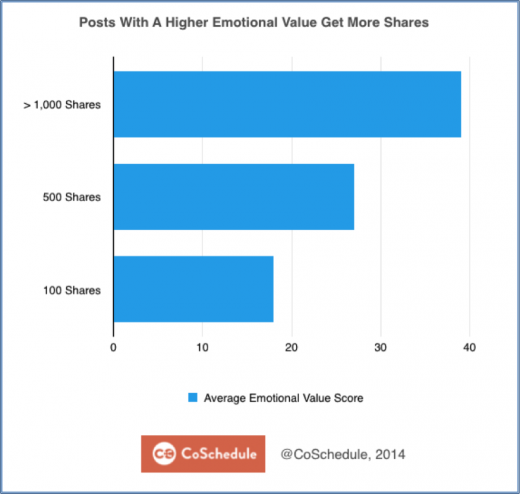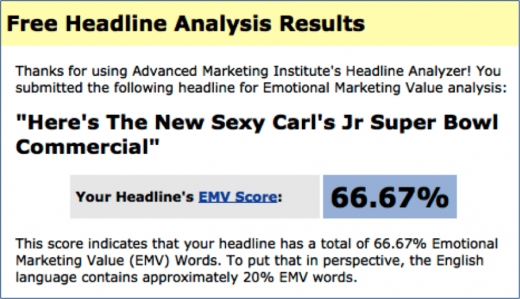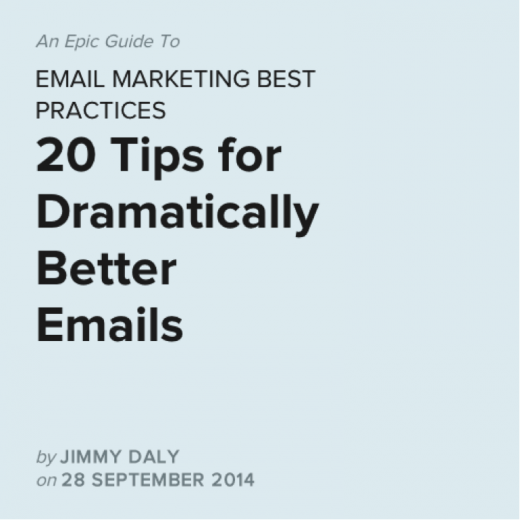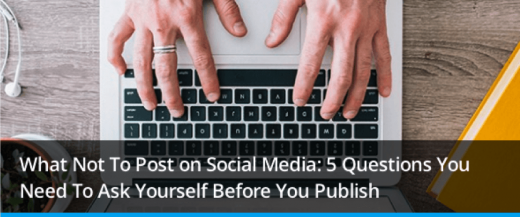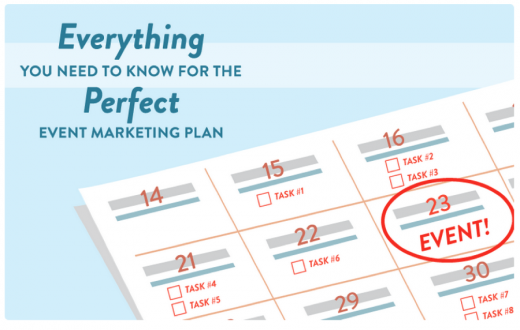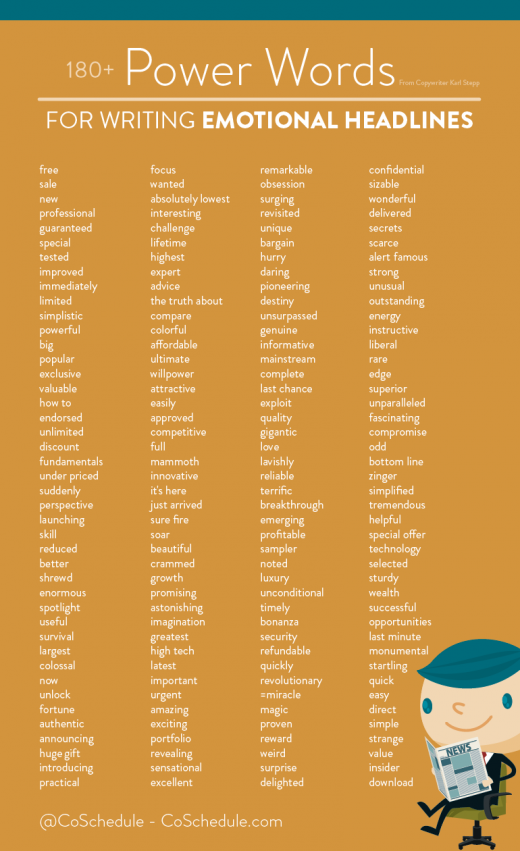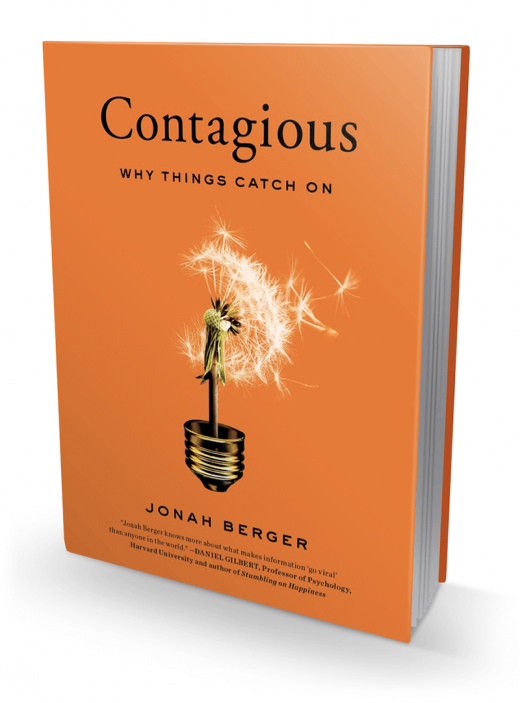
Barry Feldman is a content marketing consultant, copywriter, social media advisor and more. This post has been adapted from an original version on his blog, Feldman Creative.
I spent some serious time messing with the headline above. It’s a good one, but I’ve done better. Keep reading and you’ll understand.
First, know this: I want a lot of people to read this blog post. Bloggers generally attach great value to the number of viewers a post earns. And a proven strategy for increasing the reach of your content is to inspire readers to share it via social media.
Also, I want you to know a version of this post was published by KISSmetrics, with a headline that earned a 75.
71.4? 75? What’s with the numbers? I’m talking about emotional value, which apparently is predictable. I shall explain.
Search engine rankings aren’t everything
Selecting the perfect keywords and optimizing your post to rank high on Google is an immensely powerful tactic for increasing your reach. It’s called SEO. (Here’s SEO, nutshellified.)
SEO is clearly one of the best ways to earn eyeballs. However, success with search doesn’t come easily and rarely comes fast. Should it happen, and your post garners a spot on the first page of a search, you’re likely to enjoy a steady stream of page views over a sustained period of time.
But today we’ll look at a different strategy.
The objective: write something to earn heaps of social media shares to deliver a sudden and pronounced spike in traffic.
The key is giving your post an emotional headline
While an 8-word headline of a 1300-word post represents less than 1 percent of the content, I’m 99 percentr sure it will be the line that dictates the destiny of your post.
Whether appearing on a blog post, the subject line of an email, a Twitter update, or any of the zillion places your content may appear, your headline prompts three potential responses:
- Nothing. Your post is ignored.
- Click. Your post is presented.
- Share. Your post’s reach is magnified.
The combination of 2 and 3 is the goal and an opportunity to achieve a fourth potential response: your post gets read and its call to action is effective. This is called “conversion.”
Emotions drive actions. We need not do a deep dive on this. The principle’s understood by neuroscientists and marketers (nearly) universally. The subject I do want to dive into is writing emotional headlines to invoke a response from your readers.
Proof that emotional headlines drive social sharing
My friends at CoSchedule are all about helping content marketers blog smart and earn traffic via social media. They’re also insanely analytical. So they analyzed more than one million headlines in an effort to determine which are shared most and how such a thing might be predicted.
As you see, CoSchedule determined (in no uncertain terms) headlines with a higher emotional value get more shares on social media.
How to score your headline’s emotional value
Though it may seem counter-intuitive, emotional value can be measured. What can’t?. Advanced Marketing Institute created a tool: the emotional marketing value (EMV) headline analyzer.
You enter your headline, select a category, and submit. You get your score…
To demonstrate, I went to Topsy.com, a free tool that provides social analytics, and entered “Super Bowl.” Unsurprisingly, a story published on Huffington Post about a Super Bowl commercial currently ruled from a social shares perspective, having been tweeted 59.5K times over the past 24 hours.
I pasted the headline into the EMV headline analyzer and as you can see in the screenshot above, the headline was ultra-emotional: 66.67.
Copy on the results page explains:
For comparison, most professional copywriters’ headlines will have 30 percent-40 percent EMV Words in their headlines, while the most gifted copywriters will have 50 percent-75 percent EMV words in headlines. A perfect score would be 100 percent, but that is rare unless your headline is less than five words.
Earning big share numbers with high EMV headlines
I used BuzzSumo.com, a tool featuring a search engine that finds the most shared content for any topic or domain, to validate the power of emotional headlines and show you some examples.
A recent post from the GetVero.com blog, 20 Tips for Dramatically Better Emails, by Jimmy Daly, is Vero’s most shared of the past six months. The headline gets a 50 EMV score and has earned close to 9K shares.
The EMV headline analyzer tool also reported this headline falls in an “intellectual” classification. Intellectual impact words are ideal for arousing curiosity. The analysis adds, the majority of words with emotional impact fall into this category, are the most used, and have the broadest appeal.
Among Hootsuite’s hottest stories of 2015 is What Not To Post on Social Media: 5 Questions You Need To Ask Yourself Before You Publish, a story by Olsy Sorokina. The headline gets a 53 EMV score and has quickly earned close to 2K shares.
The EMV headline analyzer tool classified the headline as “spiritual.” According to the Advanced Marketing Institute, spiritual impact words carry the strongest potential for influence and appeal to people at a deep emotional level.
Everything You Need to Know for the Perfect Marketing Event (the headline differs slightly in the image they created), a story by Julie Neidlinger, on the CoSchedule blog gets a 55 EMV score. So far this year, the post is CoSchedule’s most shared.
And now back to the headline of this post
A few minutes ago, you learned I did a good amount of “messing” with the headline of this post. I wasn’t about to settle for a low score. I’ll show you what happened.
First, I tested the working headline I chose when the idea for this post began to gel. EMV scores follow each headline.
How to Accelerate the Reach of Your Content with Emotion-Packed Headlines (27)
The headline probably has strong SEO potential. Assuming “reach of your content” or “emotion-packed headlines” are keywords that get searched. But for EMV, I didn’t even achieve “professional copywriter” status.
So I wrote alternate headlines and scored them. Here’s what that exercise looked like:
Headlines that Move Readers Emotionally Move Them to Share Your Story (55)
You’ll Love the Astonishing Effect Emotional Headlines Have on Your Content” (55)
As you can see, I was catching on and making progress. I thought I might beat a 55 score with this one:
I used that headline when I guest posted on KISSmetrics. I didn’t want to compete with them with search rankings, so I returned to the emotional marketing value (EMV) headline analyzer and tried some more ideas so this post could have a different, but emotional, headline.
The headline I settled on scored 71.4. That’s quite good and suggests you’ll share this story. Please do. I’ve made it easy for you…
How to write emotional headlines
You understand the reason behind topping your blog posts with emotional headlines and now know of a tool to assess your ideas. Perhaps the question swimming between your ears now is “how do I write emotional headlines?”
The answer: you use powerful words, words that invoke feelings.
I did some searching and clicking in an effort to provide an emo-glossary and found a great resource here: feeling words (courtesy of PsychPage). Jon Morrow, the mastermind writer of Boost Blog Traffic dedicates a post to explaining (and listing) power words here. And finally, CoSchedule created a cheat sheet of 180+ power words.
Emotional headlines that touch readers make them feel various forms of pleasure and pain. Most notably, for pleasure, use words that invoke:
- Happiness
- Fun
- Belonging
- Awe
- Love
- Positivity
- Strength
- Empowerment
For pain, consider words that invoke:
- Fear
- Anger
- Discomfort
- Confusion
- Helplessness
- Indifference
- Sadness
Feeling drives sharing
Jonah Berger, a marketing professor at the Wharton School of the University of Pennsylvania, wanted to uncover why people share information. He and his colleagues examined hundreds of brands, thousands of articles, and millions of purchases.
Berger presented his conclusions in the New York Times bestseller, “Contagious—Why Things Catch On.” Before the book release, in a post for the “Think with Google” blog, Berger wrote, “Our results found that articles, ads, or information that evoke emotion in the reader are around 20 percent more likely to be highly shared. What we see in these cases, and many more, is that feeling drives sharing.”Want to write contagious blog posts? Apply this idea to your headlines. Choose words that touch your reader.
And hey, obviously you didn’t hate this post. Here you are at its end. Now I’d like to ask you to share it. It’ll make me look smart.
Read Next: 5 ways to keep customers engaged before they slip away
Get the TNW newsletter
Get the most important tech news in your inbox each week.
